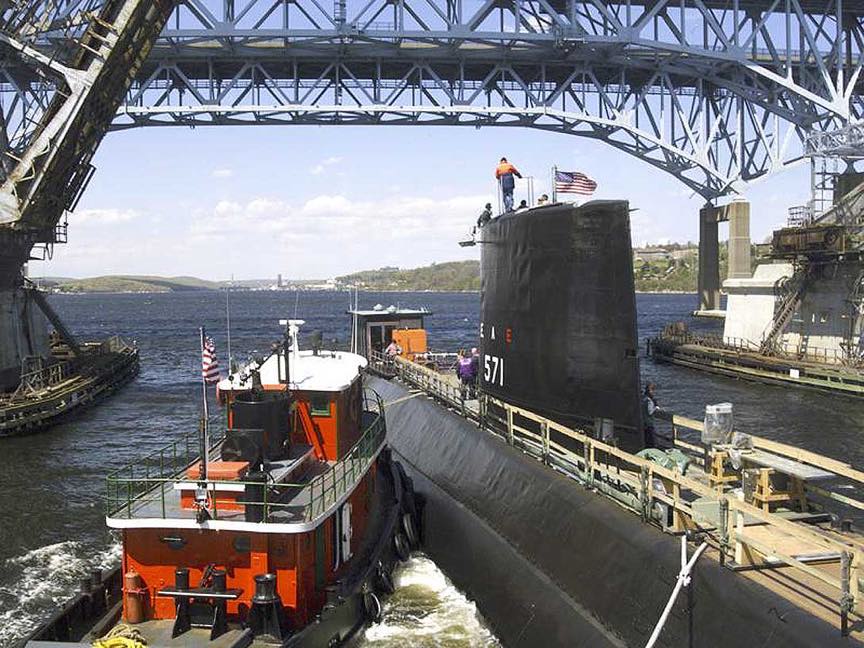Nautilus IV SSN-571

Nautilus IV
(SSN-571: dp. 3,533 (surf.), 4,092 (subm.), 1. 323'9", b. 27'8", dr. 22', s. 22 k. (surf.), 20+k. (subm.); cpl. 105:cl. Nautilus)
The fourth Nautilus, the first nuclear powered submarine was laid down 14 June 1932, President Harry S. Truman officiating, at the Electric Boat Co., Division of General Dynamies Corp., Groton, Connecticut, launched 21 January 19.;4, sponsored by Mrs. L)wight 1). Eisenhower, wife of President Eisenhower, and commissioned 30 September 1954, Comdr. E. P. Wilkinson in command.
Following Commissioning Nautilus remained at dockside for further eonstruetion and testing until 17 January 1955. Then, at 1100, her lines were east off and she was "underway For nuclear power." Trials followed and on 10 May Nautilus headed south for shakedown. She remained submerged while enroute to Puerto Rico, covering 1,381 miles in 89.8 hours, the longest submerged eruise, to that date, by a submarine, and at the highest sustained submerged speed ever recorded for a period of over one hour's duration. Throughout 1955, and into 1957, she investigated the effcets of the radically increased submerged speed and endurance, sleh changes in submerged mobility having virtually wiped out progress in anti-submarine warfare techniques. The airplane and radar which helped defeat submarines in the Atlantic during Worl] War II, proved ineffcetive against a vessel which did not need to surface, could elear an area in record time, and swiftly change depth simultaneously.
On 4 February 1957, Nautilus logged her 60,000th nautical mile to bring to reality the achievements of her fietitious namesake in Jules Verne's 20,000 Leagues Under the Sea. In May she departed for the Paeifie Coast to participate in coastal exercises and the fleet exercise, operation "Home rlm " which acquainted units of the Pacific Fleet with the eapabiiities of nuclear submarines.
Nautilus returned to New London 21 July and departed again 19 August for her first voyage, of 1,383 miles, under polar pack iee. Thenee, she headed for the Eastern Atlantic to participate in NATO exercises and eonduet a tour of various British and Freneh ports where she was inspeeled by defense personnel of those countries. She arrived baek at New London 28 October, underwent upkeep, and then conducted coastal operations until the spring.
On 25 April 1958 she was underway again for the West Coast. Stopping at San Diego, San Francisco, and Seattle, she began her history making Polar transit, operation "Sunshine," as she departed the latter port 9 June. On 19 June she entered the Chukehi Sea, but was turned back by deep draft fee in those shallow waters. On the 28th she arrived at Pearl Harbor to await better fee conditions. By 23 July her wait was over and she set a course northward. She submerged in the Barrow Sea Valley 1 August and on 3 August, at 2315 (EDST) she became the first ship to reach the geographic North Pole. From the North Pole, she continued on and after 96 hours and 1830 miles under the ice, she surfaced northeast of Greenland, having completed the first sueeessful voyage across the North Pole.
Proceeding from Greenland to Portland, England, she reeeived the Presidential Unit Citation, the first ever issued in peace time, from American Ambassador J. H. Whitney, and then set a westerly course which put her into the Tharnes River estuary at New London 29 October. For the remainder of the year she operated from her homeport, New London, Co nne eti cut .
Following fleet exercises in early 1959, Nautilus entered the Portsmouth Naval Shipyard, for her first complete overhaul (28 May 1959-15 August 1960). Overhaul was followed by ref resher training and on 24 October she departed New London for her first deployment with the 6th Fleet in the Mediterrunean, returning to her homeport 16 December.
Nautilus operated in the Atlantic, conducting evaluation tests for ASW improvements, participating in NATO exercises and, during the fall of 1962, in the naval quarantine of Cuba, until she headed east again for a two month Mediterrauean tour in August 1963. On her return she joined in fleet exercises until entering the Portsmouth Naval Shipyard for her second overhaul 17 January 1964. On 2 May 1966, Nautilus returned to her homeport to resume operations with the Atlantic Fleet. For the next year and a quarter she conducted special operations for ComSubLant and then in August 1967, returned to Portsmouth, for another year's stay, following which she conducted exercises off the southeastern seaboard. She returned to New London in December 1968, and into 1970 she continued in operations as a unit of the 2nd Fleet.
On 9 April 1979, Nautilus set out from Groton, Connecticut on her final voyage under the command of Richard A. Riddell. She reached Mare Island Naval Shipyard of Vallejo, California on 26 May 1979, her last day underway. She was decommissioned and stricken from the Naval Vessel Register on 3 March 1980.
